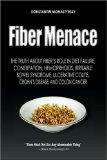What is Dietary Fibre?
Most fibres are carbohydrates. It used to be believed that fibres could not be used by the human body, as the digestive juices in the body did not contain enzymes capable of breaking down these compounds. It was overlooked that a part of the fibre is fermented by enzymes found in the micro-organisms of the large intestines. Found were both gases and short chain fatty acids which can be utilised by the body. The energy gained from fibre (2-3 kcal/g) is negligible as a result of the low amount provided. The recommended consumption by the DGE (Deutsch Gesellschaft für Ernährung - German Nutrition Society) is 30g of fibre a day. The average German eats less than the recommended amount.
Examples of dietary fibres include cellulose, hemicelluloses, pectin, nutrient agar, lignin etc.
There are two types of dietary fibres: soluble and insoluble.
Insoluble dietary fibres inhibit the ability to swell. These fibres absorb water thereby expanding the volume of the matter inside the intestines. This speeds up the bowel movements and decreases the storage period of the chyme in the intestines. If insoluble fibre is consumed in the right amounts it can prevent constipation.
Soluble fibres bind bile acids (which contain up to 80% cholesterol) as well as other metabolic products and they assist in the excretion of these products. This lessens the amount of cholesterol in the blood and lowers the cholesterol levels.
All fibres, excluding lignin, can absorb water. Bulking agents can absorb up to 100 times more water than their own weight.
Effects of Dietary Fibre:
positive effects of dietary fibre
- Prolonged satiety feeling
- Absorption and excretion of cholesterol and bile acids thereby lowering the cholesterol levels
- Quickens bowel movement
- Water absorption in the large intestine which helps to soften the stool.
- Helps prevent getting certain chronic intestinal illnesses.
- Possibly helps in lowering the risk of getting colon or other intestinal cancers.
negative effects of dietary fibre
- Bloating caused by the gas formation of the micro-organisms
- Additional contamination with xenobiotics
- Direct epithelial damages (intestinal mucosa)
- Bonding of calcium, magnesium, iron and zinc which decreases their absorption rate.
- Volvulus (twisting of the bowels) as a result of excess filling up of the large intestines.
top  |
Fibre in Foods:
Fibres are found only in plant foods in particular whole meal products, legumes, vegetables, salads, sprouts and fruit.
Fibre in 100g Foods:
Porridge: 10 g
Wheat Germ: 17,7 g
Wheat Bran: 45,4 g
Rice: 4,5 g
Crisp Bread: 14 g
Peas: 16,6 g
Corn: 9,7 g
Lentils: 17 g
Soya Beans: 21,9 g
White Beans: 23,2 g
Curly Kale: 4,2 g
Cauliflower: 26,3 g
Carrots: 12,1 g
Plums, dried: 5,0 g
Whole grain pasta: 8,0 g
Whole grain bread: 8,3 g
top 

Fiber Menace: The Truth About the Leading Role of Fiber in Diet Failure, Constipation, Hemorrhoids, Irritable Bowel Syndrome, Ulcerative Colitis, Crohn's Disease, and Colon Cancer, Konstantin Monastyrsky

The G.I. Diet
Rick Gallop

The CalorieKing Calorie, Fat, & Carbohydrate Counter
Allan Borushek
top 
|

